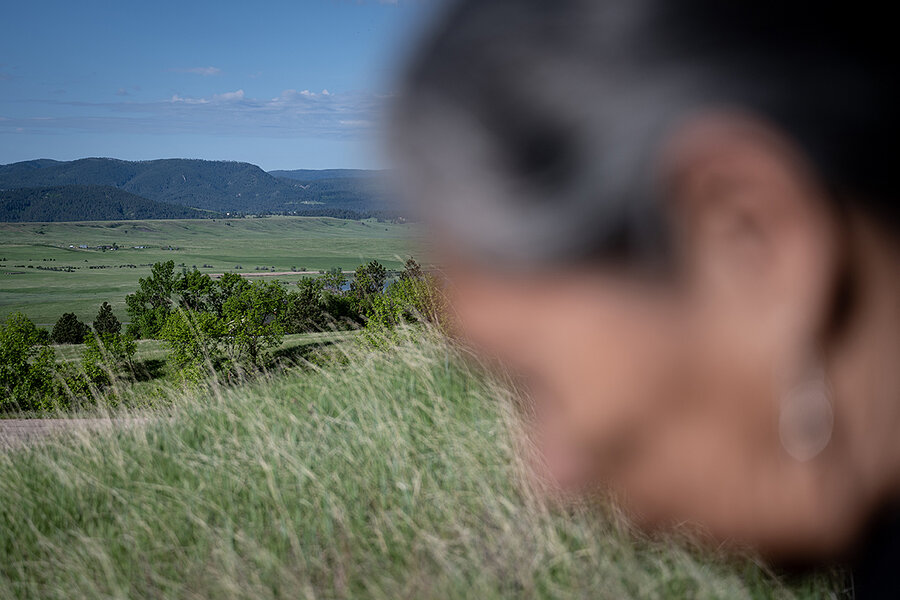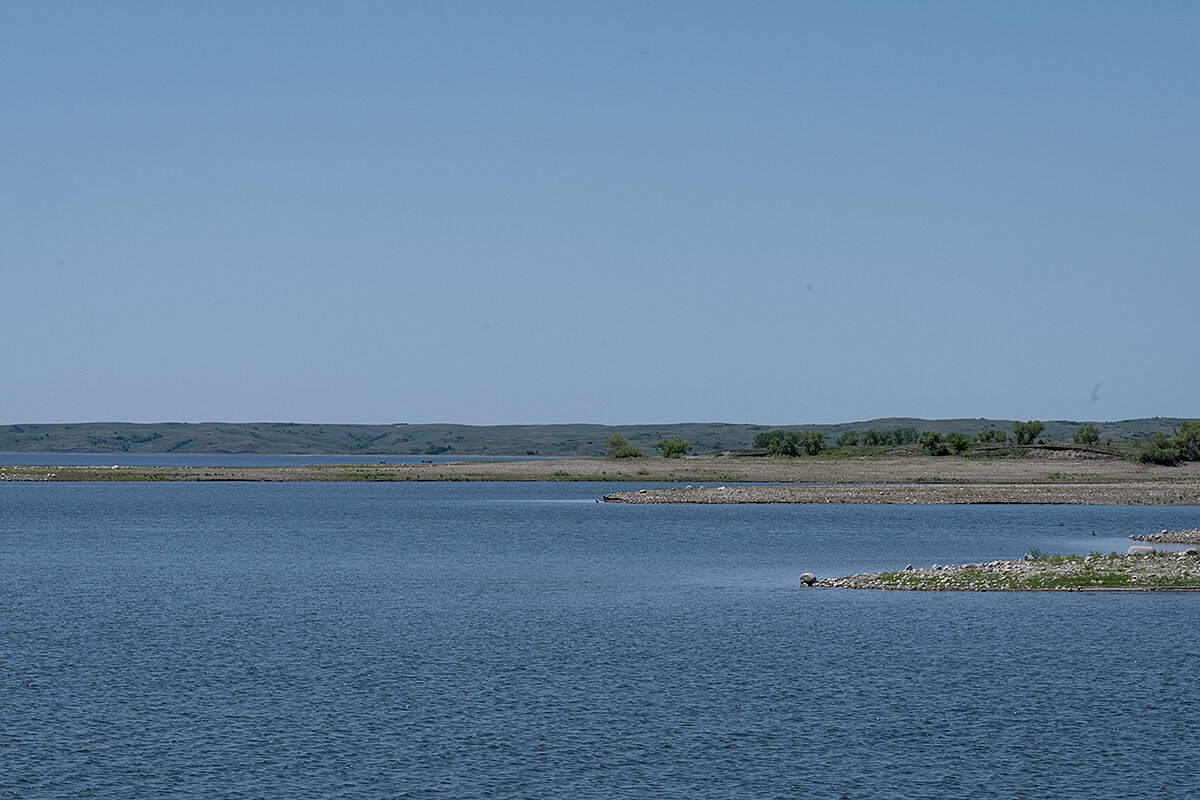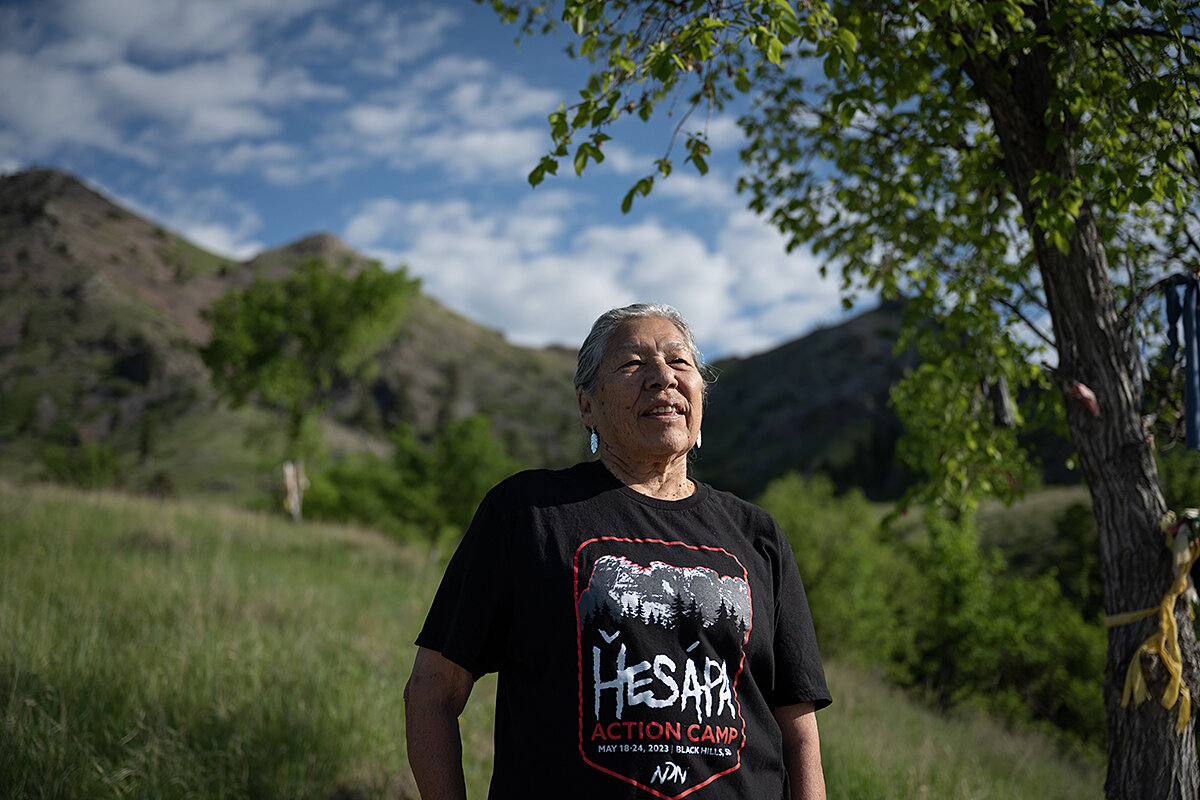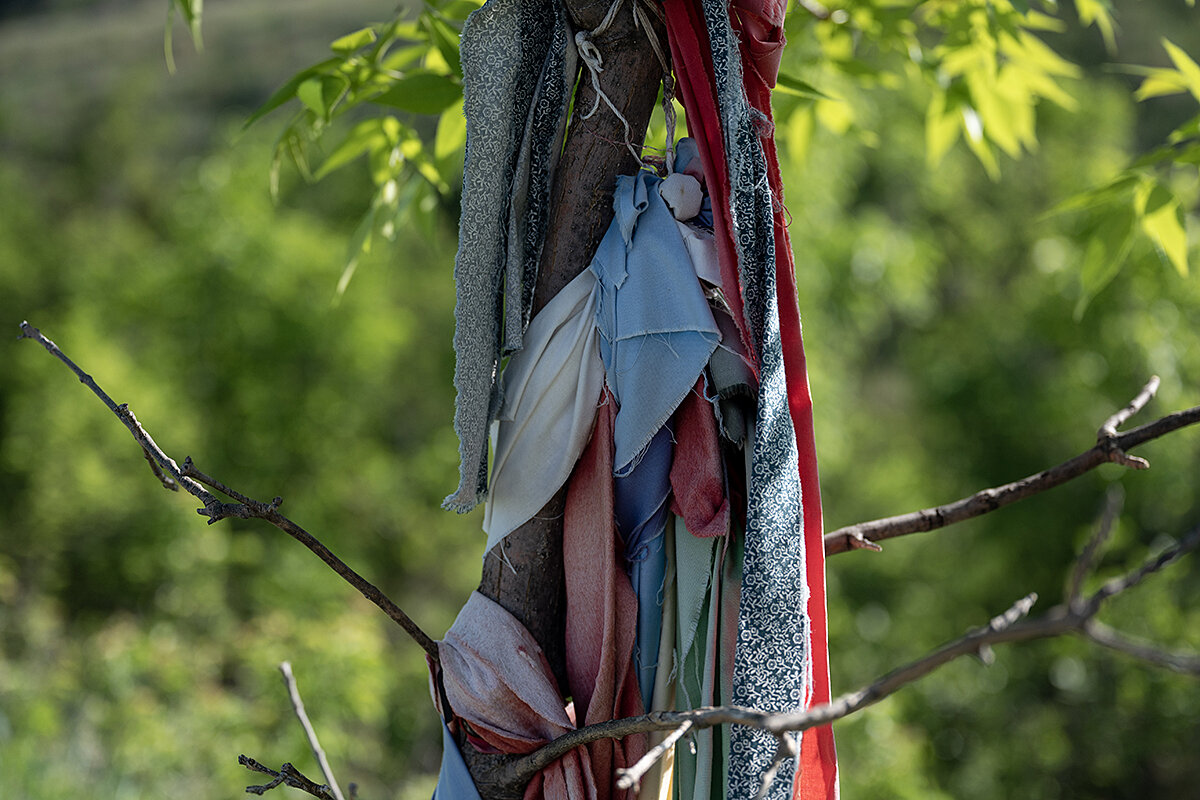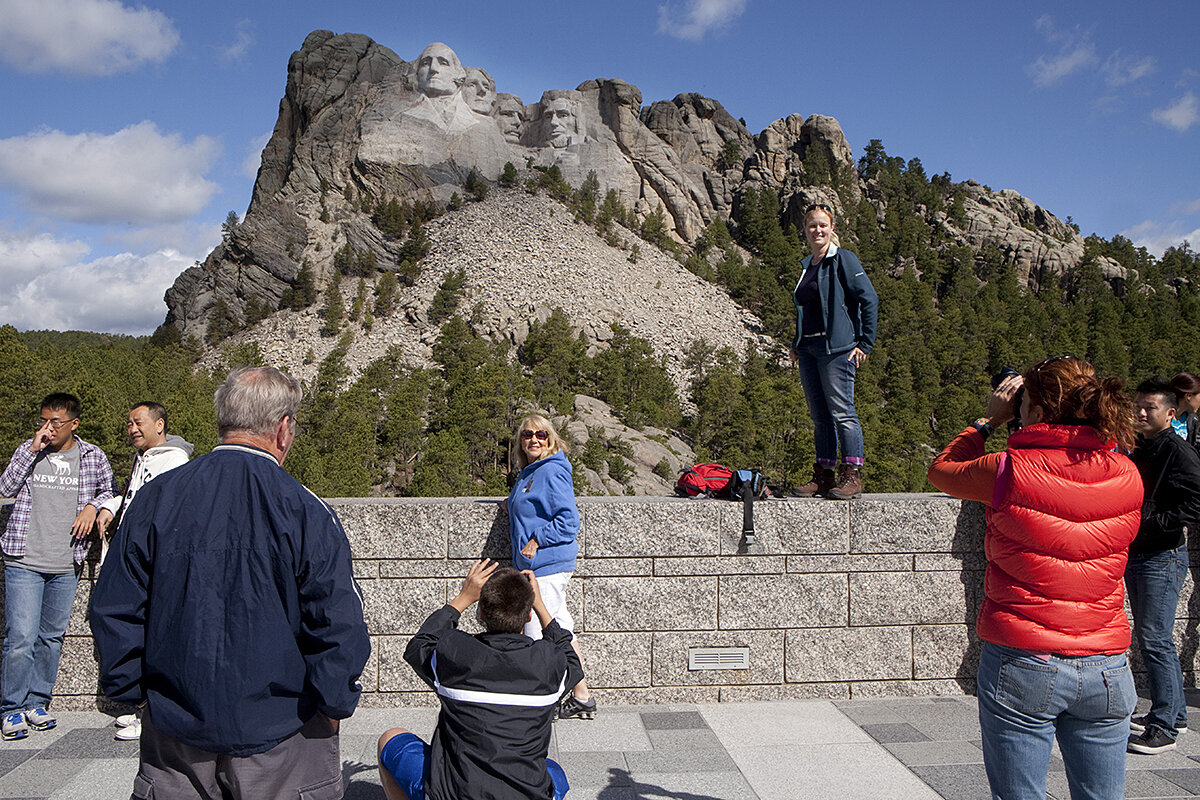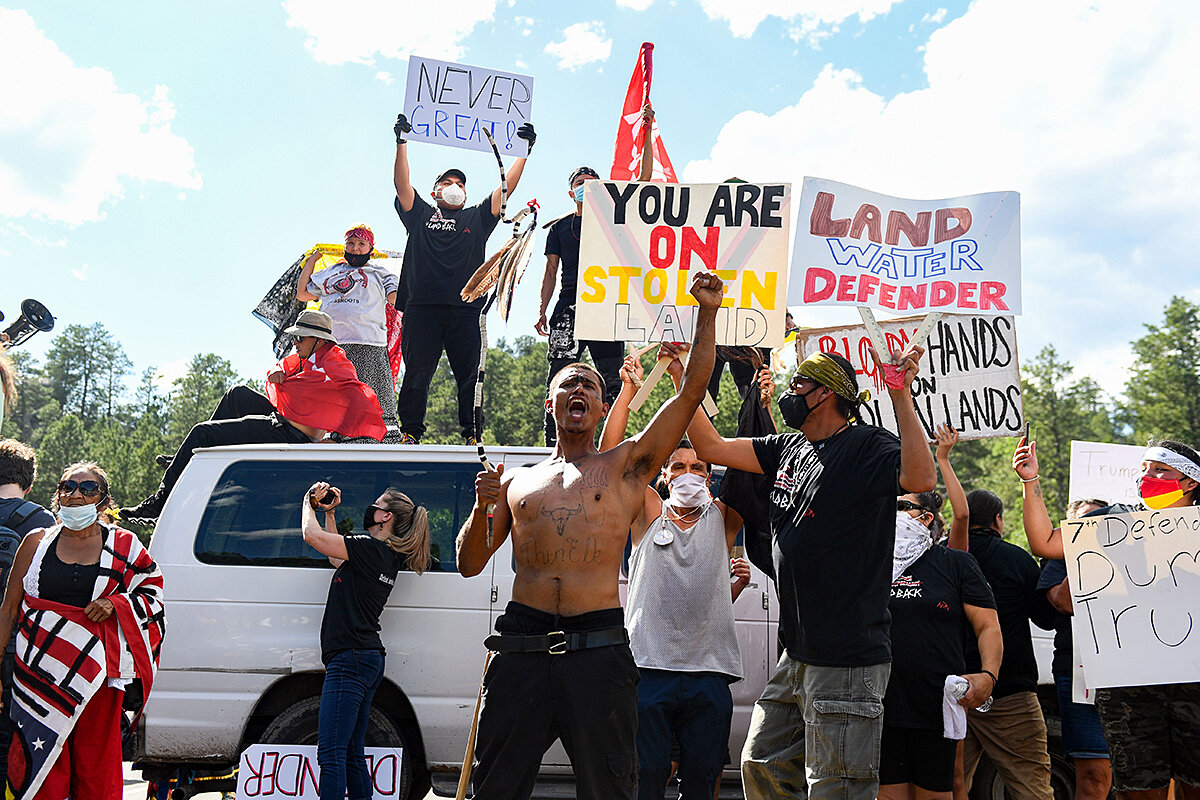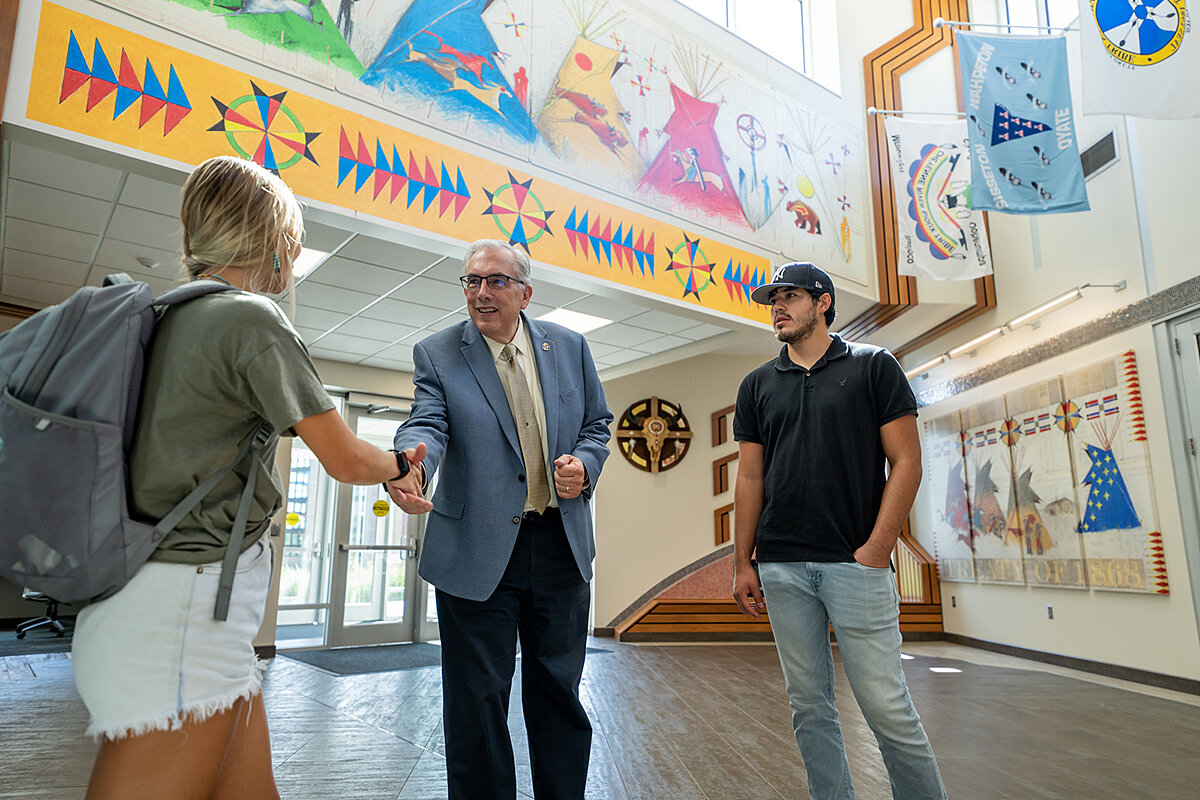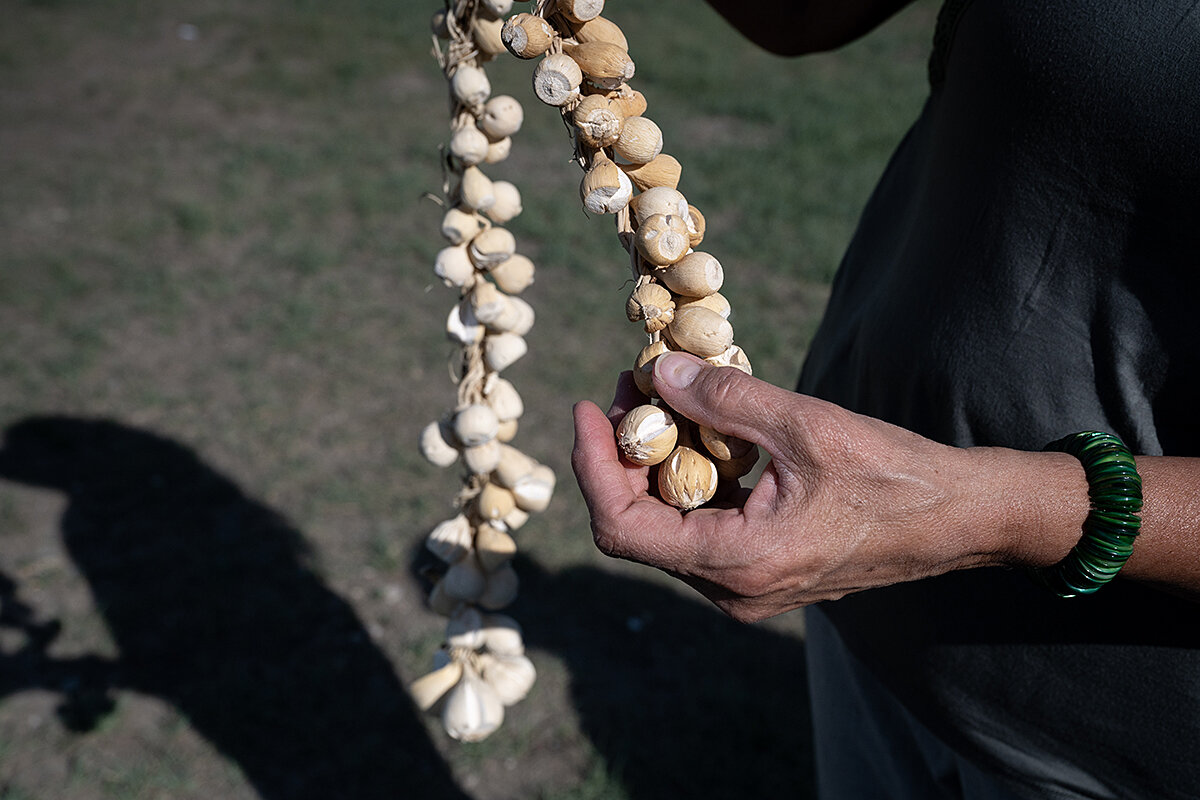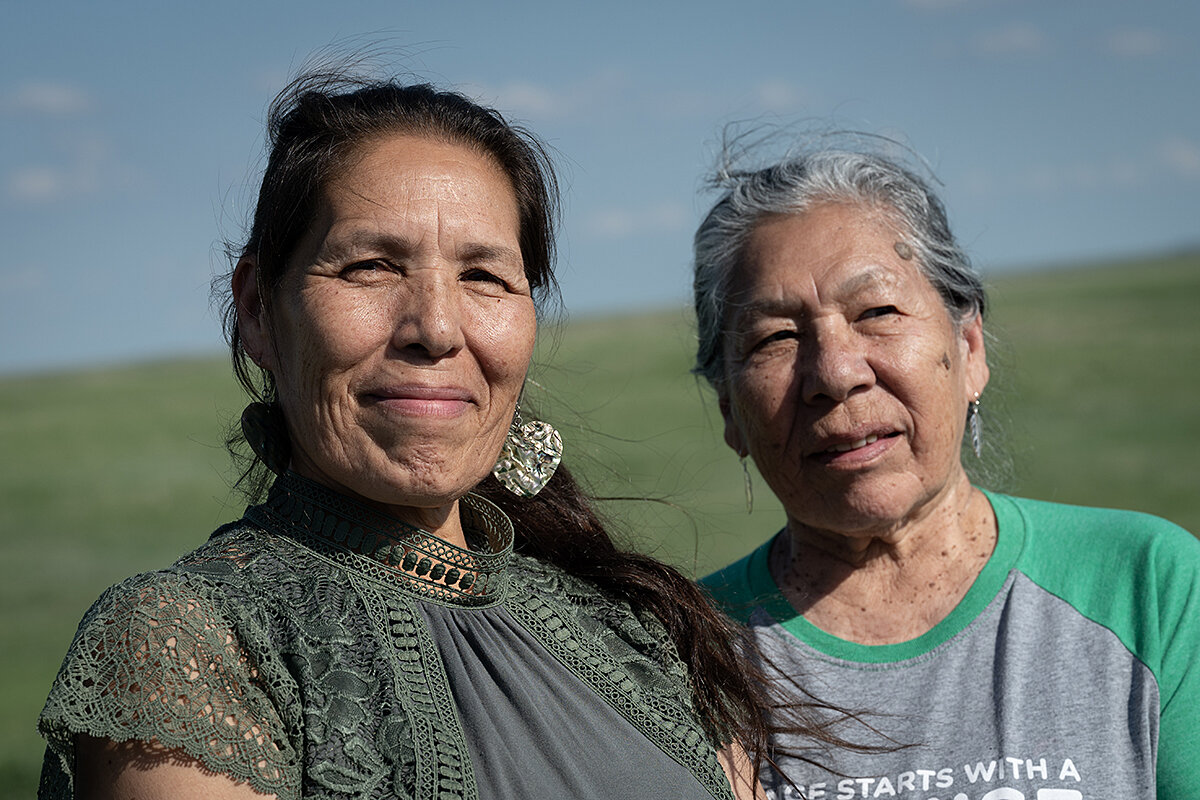When $1 billion isn’t enough. Why the Sioux won’t put a price on land.
Loading...
| Rapid City, South Dakota
It’s been decades since Madonna Thunder Hawk last saw the valley she grew up in on the Cheyenne River Reservation. It lies buried under the Missouri River. The United States government sent the river rushing over the reservation’s largest town in 1960 as part of a series of post-war federal flood control projects.
In the history of Native American land dispossession in North America, the creation of the Oahe Dam is little more than a footnote. But for Ms. Thunder Hawk, it is her footnote. She couldn’t bear to watch the water consume the land. Then in her early 20s, she says she didn’t fully appreciate that, in various guises, this had been happening to her ancestors for centuries.
The dam wasn’t illegal, or even militaristic – though the U.S. Army Corps of Engineers built it. As with the 370-plus treaties that tribes have negotiated with the government, Ms. Thunder Hawk’s father received some compensation. Like many of those tribes, he didn’t want the money. He wanted to preserve the land.
Why We Wrote This
A story focused onHow do you make reparations for historic harm when money is off the table? To accept cash for stolen land would be to sell out in the purest sense, members of the Sioux say. They want their land – or at least a say in how it is protected.
Ms. Thunder Hawk says she doesn’t know how much he got in compensation, or what happened to the money. What she knows is she will never be able to return to the land. She knows the story of that land is the story of Indigenous people around the world, which is to say it’s the story of colonization in America. A story of land taken with ruthless speed and the faintest of legal justifications.
The scale of land loss is hard to quantify. One study estimates that tribes have, on average, 2.6% of the land base they had before 19th-century forced migration. And the great irony is that members of the Sioux, like Indigenous peoples around the world, never viewed land as belonging to them. Like blades of grass on the plains, they consider themselves a natural extension of the land, and the land a natural extension of them. Land is not property in their eyes, which is why, some say, they lost so much of it so easily.
“We are this land,” says Ms. Thunder Hawk. “We have to stand and struggle for what we have left.”
American settlers, with a diametrically opposed worldview, drove westward. They forced Native tribes onto reservations (often on the least desirable land) and, over the generations, into boarding schools and cities. Families were separated and cultures erased, all with the intention of taking, and keeping, land that Indigenous people had called home for centuries.
Ms. Thunder Hawk, a Lakota great-grandmother, grew up with this history, connected to her culture and history only by gossamer threads. One of those threads was the land, and over decades of work as an activist, she has called for it to be returned.
Nowhere is this struggle more pronounced than in the Black Hills of South Dakota. The Supreme Court said in 1980 that the area, sacred to Native people for 12 centuries, was taken in such egregious fashion that the government owed the Sioux tens of millions of dollars in compensation.
But members of the Sioux – a confederation of seven primarily Dakota and Lakota tribes who now occupy some of the most impoverished counties in the country – have steadfastly refused the award, which is now worth over $1 billion. Generations of systemic poverty – and broad disparities in health, education, and criminal justice outcomes – cannot be repaired with money, they say.
For people who view themselves as indistinguishable from the land, any efforts to right historic wrongs must be land-based. And the Black Hills has become the epicenter of those efforts – specifically the “Land Back” movement, a social justice campaign calling, broadly, for increased Indigenous sovereignty and equity.
“Tribal nations would like to have the land that they’ve called home since time immemorial returned to them. That’s a pretty big ask though,” says Kevin Washburn, a former assistant secretary of Indian Affairs and a citizen of the Chickasaw Nation.
“I’m a realist, and I’m pragmatic,” he adds.
In some cases, physical land could be returned, but the practicalities of it are, in many ways, impractical. For some tribes, centuries of assimilationist policies have completely severed connections to their ancestral lands. For others, like the Inupiat in northern Alaska, the land has never really been lost. In recent years, the scope of Land Back has broadened. Advocates say concrete policies – from national parks co-management to investments in urban services – can achieve what Land Back is really about: forging a new, more equitable, relationship between America and Native peoples.
“There are a whole bunch of things that fall on the spectrum of Land Back that may not fully be [returning] land but nevertheless move the ball in the right direction,” says Mr. Washburn.
“One size doesn’t fit all,” adds Frank Pommersheim, an emeritus professor at the University of South Dakota.
“The goal is to discuss things [that happened] in the past so we can go forward together to make a better history,” he says. “To me, that’s an incredibly worthy endeavor.”
On Bear Butte
Unlike Mount Rushmore 70 miles south, Bear Butte has changed little over the centuries. Those who come here to fast and pray see largely the same quiet, rugged landscape ancestors like Red Cloud and Crazy Horse saw.
It’s one of the reasons Ms. Thunder Hawk likes to visit. One morning in May, she stands at the foot of the mountain, bathing in the sunlight, listening to prayer cloths and tobacco ties rustle in wind-tossed trees.
“It’s good to come back every once in a while,” she says. “It’s mostly reminiscing, remembering who was once here.”
This is where tribes of the Great Plains have always come to prepare for the Sun Dance, a sacred rite individuals carry out for healing and good fortune. Ms. Thunder Hawk would camp with family in the foothills, supporting relatives who were fasting and praying on the mountain for days.
“It’s a place of spiritual gathering,” she adds. “Our spirituality, it’s a family affair. ... That’s tradition, that’s the ways of our ancestors. Keep the family strong.”
Familiar with its spiritual significance, the U.S. government included the Black Hills in negotiating the Treaty of Fort Laramie in 1868. In exchange for halting attacks on railroads and settlers, the government promised the Sioux tribes “the absolute and undisturbed use and occupation” of roughly half of present-day South Dakota. Six years later, an expedition led by Lt. Col. George Armstrong Custer discovered gold. In 1877, with a gold rush in full swing, Congress claimed the land through eminent domain.
The Sioux tribes never stopped fighting for the Black Hills. In 1975, they won – at least in court.
“A more ripe and rank case of dishonorable dealings will never, in all probability, be found in our history,” the U.S. Court of Claims wrote, describing the Black Hills seizure. Upheld by the U.S. Supreme Court in 1980, the ruling entitled the Sioux tribes to over $100 million.
But to this day, the tribes have refused to take it.
“The Black Hills are not for sale,” says Frank Star Comes Out, president of the Oglala Sioux Tribe. “Our tribes do not want the money. They want the land back.”
The Black Hills are also now a tourism hotbed. From Mount Rushmore to the Sturgis biker rally, visitors spent $1.8 billion in western South Dakota last year, according to the state tourism office. That’s roughly what the Sioux tribes are owed for the Black Hills. As of 2011, the award – held in a trust by the Bureau of Indian Affairs – had increased to $1.3 billion.
But for the Oglala Sioux – located on the Pine Ridge Reservation, the second-poorest county in the U.S. – even $2 billion wouldn’t undo centuries of systemic neglect, says Ms. Thunder Hawk. If anything, it would do the opposite. The tribes would be selling out in the purest sense, investing in what the Black Hills have become, not what they believe it to be.
“What, you’re going to buy and sell your mother?” she says. “Once we do that, there goes our birthright.
“We would no longer be,” she adds. “We wouldn’t be who we are. Because that means we are for sale. They bought us.”
“A sense of setting things right”
But would getting land back do anything to repair centuries of harm and neglect? The outgoing mayor of Rapid City, the de facto capital of the Black Hills, thinks so.
In 2017, Steve Allender began working with local officials and Native groups to effectively sell three parcels of land – which had been part of the site of the Rapid City Indian Boarding School, and which Congress had ordered be given to groups including “needy Indians” – and develop them in ways that would benefit local Native communities.
In essence, a behavioral health center, a senior living community, and an activity center were to be converted into a Native American community center, headquarters for a Native economic development organization, and a permanent memorial for children who died at the boarding school.
Mayor Allender says he has always wanted to make some kind of investment in the city’s Native community. When you combine residents and day visitors, he notes, one-quarter of Rapid City’s daily population is Indigenous.
“We do a lot of talking about being equal and being one community,” he says. “But there’s really little in our actions to show we’re serious about that.”
But after years of discussions and disputes over land value, financing, and what the land should be used for – interrupted by the pandemic – the effort has largely ground to a halt. The children’s memorial is being built on the land, on what is believed to be unmarked grave sites.
Speaking on the day Rapid City voters were picking his successor, Mayor Allender says he still hopes for a positive outcome.
“I’m just imagining that this can be good for all of us because we will live in an environment where we’re not afraid to go in the past and acknowledge something, not afraid to make a bold move forward,” he says. “That has benefits for everyone, in a sense of pride, a sense of community, a sense of setting things right.”
“There are folks that feel ignored, or feel cheated,” he adds. “Maybe this offers a glimmer of hope that it doesn’t have to be this way for eternity.”
A new beginning
There is more to the Land Back movement than physically returning land, however. South Dakota State University has been illustrating how.
After becoming the school’s president in 2017, Barry Dunn – an alumnus and member of the Sicangu Lakota – launched the Wokini Initiative (Lakota for “new life” or “new beginning”).
Through the initiative, the university now publicly acknowledges the tribal land SDSU now occupies, and it works to provide greater access to higher education for Native Americans in the state. Recruiters visit high schools on the state’s nine reservations, more scholarships are being offered to Native American students, and a Native American student center has been built on campus.
For a public university created with land taken from tribal reservations by the 1887 Dawes Act, this is Land Back in action, says President Dunn.
“I don’t have the authority or responsibility to give it back, but I can make the decisions ... that we’ll take the proceeds we receive from our land every year and dedicate it to the American Indian students here on campus,” says President Dunn.
“It’s poetic, and I think appropriate, that that’s how we address it,” he adds.
When Marcella Gilbert, Ms. Thunder Hawk’s daughter, returned to the Cheyenne River Reservation after graduating college, she set to teaching communities about wild foods and their benefits. She later got a scholarship to pursue a master’s degree at SDSU studying the nutritional value of the reservation’s wild foods. The university later helped her get a grant so she could plant wild foods on the reservation and teach people how to grow their own food.
It may surprise people, Ms. Gilbert says, but Land Back efforts are needed not just on land taken by the government, but also on land given by the government.
“These reservation lands aren’t really ours,” she adds.
The Dawes Act authorized the U.S. government to break up reservation land into individual allotments. The ultimate effect was that private landowners purchased vast tracts of reservation land on decadeslong leases. As of 2014, the Cheyenne River Sioux Tribe owned only about half of its reservation land – with most of the most fertile land along the central Highway 212 in private hands.
The effects have been numerous, from entrenching poverty to eroding traditional practices like hunting and gathering wild foods. About a quarter of her tribe’s members still are hunter-gatherers, says Ms. Gilbert, but private lease-holders block access to their land, and widespread cattle grazing has led to the near eradication of wild fruits and vegetables.
“This is our land. We should be able to have access to food,” says Ms. Gilbert.
The National Parks Service, for its part, has been working to give tribes access to their ancestral lands.
The agency has cooperated with tribes at some national parks and monuments since at least the 1970s, but they have sought to boost those relationships in recent years. There are currently four parks where the agency has a co-management agreement with tribes. Last year the National Park Service released new guidance “to improve federal stewardship of national park lands and waters by strengthening the role [of tribal entities] in federal land management.”
On a morning drive into the Pine Ridge Reservation, Ms. Thunder Hawk witnesses this firsthand. Stopping at a Visitor Center for Badlands National Park – a section of which is co-managed with the Oglala Sioux Tribe – she notices two Native women in park ranger uniforms adjusting the daily “fire danger” sign.
“That never happened in the past, ever,” she says. “Now that’s a working relationship.”
Ms. Thunder Hawk would like to see those partnerships deepen. Indeed, as much as anything, the Land Back movement is about creating working relationships. It’s about a continuation of the movement, since the 1960s, away from assimilation and paternalism and toward Native self-determination and cooperation. Tribal governments, Native people, want sovereignty. This is to say they want the power to do things, not simply have things – like the seizure of the Black Hills, or the sale of reservation lands, or the construction of the Oahe Dam – done to them.
“When I think of Land Back that’s what I think of,” says Ms. Gilbert. “We haven’t been given that opportunity to participate.”
On a warm May afternoon, she’s standing outside her home on the Cheyenne River Reservation, her youngest granddaughter sleeping in her arms. Two of her other granddaughters play in the grass and mud around her. Dogs sleep in the shade of her porch while breeze-tossed clothes dry on a washing line.
Summer feels around the corner, the time of year when she and Ms. Thunder Hawk will take the young girls to the Missouri River a few miles away. There, they will play in the water high above land once filled with ancient cottonwood trees, land her grandfather once owned. They can never get those cottonwoods back, or her grandfather’s land.
But with the Land Back movement, Ms. Gilbert thinks they can get much more. Homes are gone, but they can build new, affordable, sustainable housing on reservations, as Ms. Thunder Hawk has helped do. The cottonwoods are gone, but with the help of an SDSU grant, Ms. Gilbert planted a grove of chokecherry trees. The sacred trees – used in ceremonies and arrow-making, among other things – flowered last spring.
Land Back “gives our people hope that we can be allowed to participate in the solution,” says Ms. Gilbert. “We do have something to offer.”
And while she laughs at the idea of closing Mount Rushmore or evicting homeowners and businesses – she struggles to imagine what would happen – one day they might even get the Black Hills.
She shakes her head at what that could look like.
“It’s not about kicking you off,” she says. “It’s about taking care of [the land] and bringing it back to its sacredness.”
This story was produced as part of a special Monitor series exploring the reparations debate, in the United States and around the world. Explore more.




